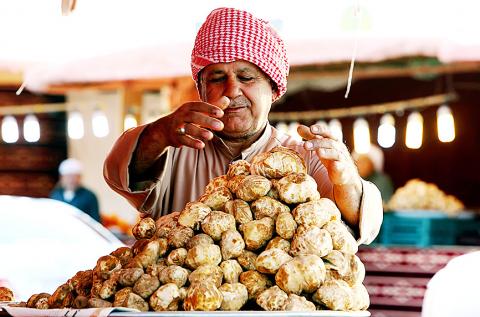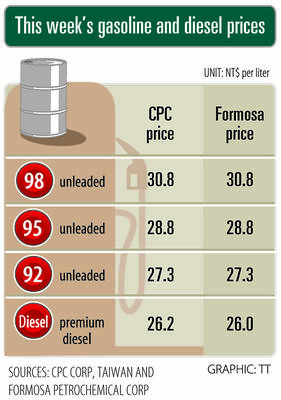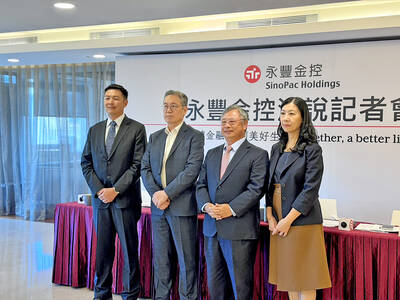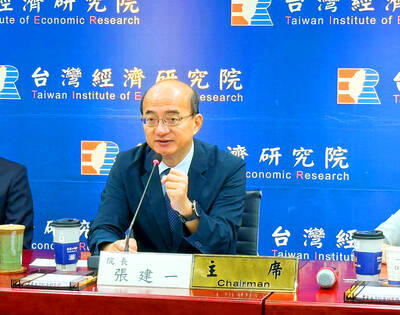White or beige, but never black, the “desert truffle” is a rare delicacy with a dedicated marketplace in Kuwait, where remnants of the Iraqi invasion and changing weather patterns have decimated local production.
Less prestigious and less expensive than its darker cousin, the Middle Eastern truffle is a prized ingredient for Bedouins, who integrate it into their traditional rice and meat dishes or in sauces, boiled with onions.
On the outskirts of Kuwait City, in al-Rai industrial district, connoisseurs begin perusing the truffle souk at 9am, surveying the various weights and colors and using their noses to select the best fungus by smell.

Photo: AFP
Some barter while others go straight for the top shelf, with the “Zebidi” variety especially prized for its use in traditional recipes.
Demand is so high in the Persian Gulf emirate’s market that each year hundreds of merchants compete for limited stall space during the cooler winter months.
The market was devised by the municipality of al-Rai, an industrial zone just northwest of Kuwait City that oversees quality control and guarantees the traceability of the fungus.
“We decided to build this market in 2006 to organize sales of this product, which you used to find in all sorts of corners in Kuwait,” Kuwait City Vice Governor Faisal al-Jomaa said.
This year, 520 merchants applied for one of the 9m2 stalls, he said.
Just 123 vendors secured space.
One of them was Iranian Abdel Ali Said, who has bought and sold truffles since the 1960s.
“They come from Iran, Saudi Arabia, Morocco, Tunisia, Libya and beyond,” he said of his truffle selection.
Prices range from 7 to 20 Kuwaiti dinars (US$23.36 to US$66.74) per kilogram, depending on the quality, he said.
This year, the market is reportedly flooded with truffles from Libya.
“That happens every six years,” Kuwaiti merchant Mohammed al-Shammari said in the truffle market.
“Production is cyclical. You also have a lot coming from Tunisia this year,” he added.
To drive home exactly how popular truffles are among Kuwaitis, al-Shammari said that “three to four tonnes are imported daily, and sold fresh.”
However, for all its love of truffles, Kuwait’s own commercial cultivation and harvesting of the fungus has plummeted to zero since Iraq invaded the Persian Gulf emirate in 1990.
The risk of coming across an unexploded land mine left behind by the Iraqi Army keeps Kuwaitis from scouting the desert for wild truffles. The only remaining production is purely for personal consumption.
Kuwait’s truffle crops have also been hit by a changing environment.
Unlike European truffles, which grow under tree roots, desert truffles spring up after rain, which means that volume and quality vary according to the amount of precipitation and the general weather.
“Irregular rainfall, rapid urbanization and encroachment on the desert are all factors in the disappearance of [local] truffles,” al-Jomaa said.
That has only increased desire for the delicacy, especially for making Kabsa, a spiced rice speciality common throughout the Persian Gulf and the most popular dish in Kuwait.
The main ingredients are long-grain rice, red meat and truffles, used to flavor the broth while cooking.
“Kuwaitis are addicted to truffles, because they are rare and have such a distinct taste,” said Yousef Mohammed al-Khaled, a young truffle aficionado, who claims he can distinguish between various subvarieties.
Khaled said he spends up to 3,000 dinars each year on white truffles, which he incorporates into his diet twice a week, including family lunches on Thursdays, the last day of the work week.
Fresh truffles are only available from November to April in Kuwait, but some vendors sell a dried variation of the delicacy during the region’s scorching summer months in a bid to meet their customers’ cravings all year round.

SETBACK: Apple’s India iPhone push has been disrupted after Foxconn recalled hundreds of Chinese engineers, amid Beijing’s attempts to curb tech transfers Apple Inc assembly partner Hon Hai Precision Industry Co (鴻海精密), also known internationally as Foxconn Technology Group (富士康科技集團), has recalled about 300 Chinese engineers from a factory in India, the latest setback for the iPhone maker’s push to rapidly expand in the country. The extraction of Chinese workers from the factory of Yuzhan Technology (India) Private Ltd, a Hon Hai component unit, in southern Tamil Nadu state, is the second such move in a few months. The company has started flying in Taiwanese engineers to replace staff leaving, people familiar with the matter said, asking not to be named, as the

The prices of gasoline and diesel at domestic fuel stations are to rise NT$0.1 and NT$0.4 per liter this week respectively, after international crude oil prices rose last week, CPC Corp, Taiwan (台灣中油) and Formosa Petrochemical Corp (台塑石化) announced yesterday. Effective today, gasoline prices at CPC and Formosa stations are to rise to NT$27.3, NT$28.8 and NT$30.8 per liter for 92, 95 and 98-octane unleaded gasoline respectively, the companies said in separate statements. The price of premium diesel is to rise to NT$26.2 per liter at CPC stations and NT$26 at Formosa pumps, they said. The announcements came after international crude oil prices

SinoPac Financial Holdings Co (永豐金控) is weighing whether to add a life insurance business to its portfolio, but would tread cautiously after completing three acquisitions in quick succession, president Stanley Chu (朱士廷) said yesterday. “We are carefully considering whether life insurance should play a role in SinoPac’s business map,” Chu told reporters ahead of an earnings conference. “Our priority is to ensure the success of the deals we have already made, even though we are tracking some possible targets.” Local media have reported that Mercuries Life Insurance Co (三商美邦人壽), which is seeking buyers amid financial strains, has invited three financial

CAUTION: Right now, artificial intelligence runs on faith, not productivity and eventually, the risk of a bubble will emerge,’ TIER economist Gordon Sun said Taiwanese manufacturers turned more optimistic last month, ending a five-month streak of declining sentiment as concerns over US tariffs, currency volatility and China’s overcapacity began to ease, the Taiwan Institute of Economic Research (TIER) said yesterday. The manufacturing business confidence index rose 1.17 points from June to 86.8, its first rebound since February. TIER economist Gordon Sun (孫明德) attributed the uptick to fading trade uncertainties, a steadier New Taiwan dollar and reduced competitive pressure from Chinese producers. Taiwan’s semiconductor industry is unlikely to face significant damage from Washington’s ongoing probe into semiconductors, given the US’ reliance on Taiwanese chips to power artificial